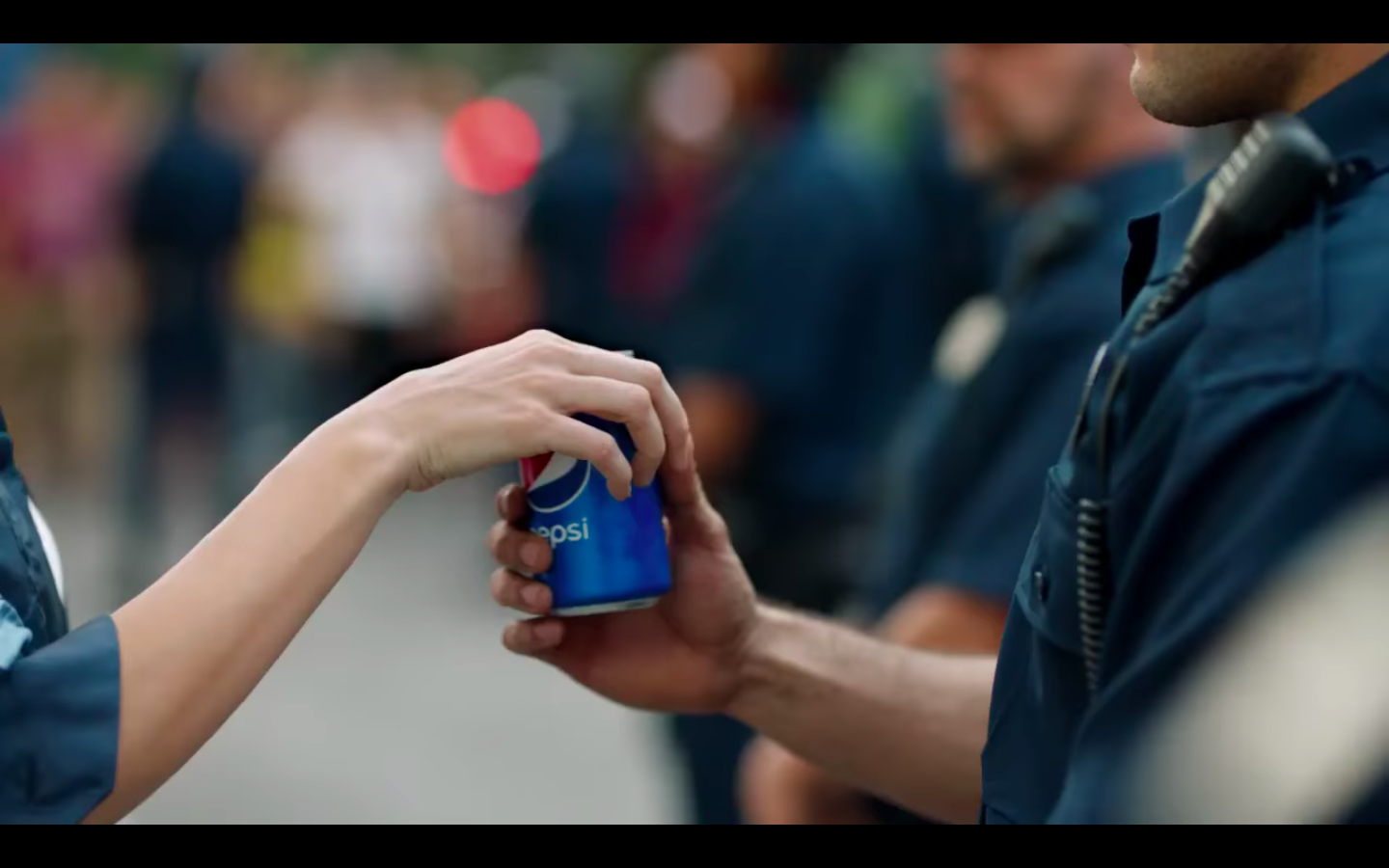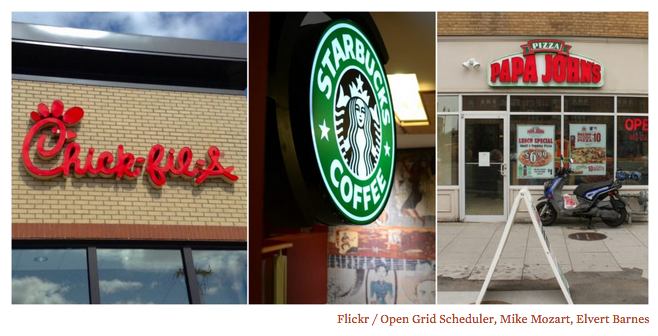New Food Economy: How do you sell feel-good food in the age of outrage?
Brands used to be politically neutral. But the rules no longer apply.
by Jessica Fu | January 30th, 2018
You remember Pepsi’s infamous 2017 “Resistance” ad, right? The one in which hoards of energetic young people took to the streets to rally for no cause in particular, where musicians and photographers marched alongside their peers, holding signs demanding a “conversation,” and which concluded with model Kendall Jenner handing a conciliatory can of Pepsi to a cop—an image that invoked the very real-life photo of Baton Rouge, Louisiana protester Iesha Evans, standing off in front of police in riot gear during a 2016 demonstration against law enforcement’s treatment of African-Americans.
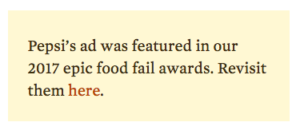 If you remember the ad, which aired on April 4, 2017, then you likely also remember the instant backlash. Social media users took Pepsi to task for trivializing and misappropriating activism. Critics scratched their heads, wondering how it had gotten approved. One day later, on April 5, Pepsi pulled the and issued this apology: “Pepsi was trying to project a global message of unity, peace and understanding. Clearly, we missed the mark and apologize.”
If you remember the ad, which aired on April 4, 2017, then you likely also remember the instant backlash. Social media users took Pepsi to task for trivializing and misappropriating activism. Critics scratched their heads, wondering how it had gotten approved. One day later, on April 5, Pepsi pulled the and issued this apology: “Pepsi was trying to project a global message of unity, peace and understanding. Clearly, we missed the mark and apologize.”
Flash forward 10 months and Pepsi’s ad looks less like it missed the mark because it failed to project a global message of unity, peace, and understanding. Rather, it missed the mark because it failed to recognize that unity is no longer the common currency of our time.
Politics is.
And specifically, politics of the polarizing, two-party kind: An October 2017 report by the Pew Research Center found that the divide between Republicans and Democrats, which reached record levels during the Obama administration, has since widened into a full-blown schism under President Trump. (In fact, Pew found that the country is at its most divided since the nonpartisan fact tank began studying the split in 1994.)
It should come as no surprise, then, that the most notable finding of a recent survey conducted by brand intelligence company Morning Consult on which brands most divide Democrats and Republicans, was this: “Brands that were once dutifully neutral have taken bold stands, and others have been involuntarily dragged into controversy.”
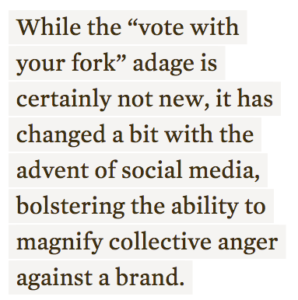 The inaugural edition of Morning Consult’s “Most Polarizing Brands” report is based on more than 336,00 online surveys conducted across a sample of U.S. adults who identified as Republican, Democrat or Independent, from October 3, 2017 to January 2, 2018. To establish the list, respondents were asked to indicate whether they had a favorable or unfavorable view of each brand. The final ranking reflects which brands had the biggest difference in their net favorability score—favorable ratings subtracted by unfavorable ratings—between Democrats and Republicans.
The inaugural edition of Morning Consult’s “Most Polarizing Brands” report is based on more than 336,00 online surveys conducted across a sample of U.S. adults who identified as Republican, Democrat or Independent, from October 3, 2017 to January 2, 2018. To establish the list, respondents were asked to indicate whether they had a favorable or unfavorable view of each brand. The final ranking reflects which brands had the biggest difference in their net favorability score—favorable ratings subtracted by unfavorable ratings—between Democrats and Republicans.
Three of the top 30 “most polarizing brands,” according to the report, are familiar food and beverage companies—Chick-fil-A, Papa John’s, and Starbucks. What do they have in common? All three have made their socio-political leanings publicly known.
In 2012, Chick-fil-A’s President Dan Cathy told the Baptist Press news service that the $4 billion company was “guilty as charged” of supporting and promoting to its employees “the biblical definition of the family unit.” A call to boycott quickly followed.
As we previously reported, Papa John’s former chief executive officer John Schnatter blamed NFL leadership—and by proxy, players kneeling to protest police brutality—for the company’s poor 2017 sales. Schnatter later apologized for his remarks.
In perhaps the most boldly partisan move of all, Starbucks’ former CEO Howard Schultz publicly endorsed Democratic candidate Hillary Clinton during the 2016 presidential election. Following Donald Trump’s inauguration, the chain pledged to hire 10,000 refugees over five years.
While the “vote with your fork” adage is certainly not new—journalist and author Michael Pollan used it to encourage conscious consumerism in a New York Times column back in 2006—it has changed a bit with the advent of social media, bolstering the ability to magnify collective anger against a brand. Increasingly quick responses from food and beverage companies in the form of public apologies and retractions have conditioned us to expect instant gratification from our outrage, too.
Take, for example, #GrabYourWallet’s #Boycott list, a trending Twitter campaign started by Shannon Coulter and Sue Atencio that encourages people to stop buying from brands that endorsed or supported President Trump’s election campaign. It includes food and beverage company targets like MillerCoors and Wegmans. Then there is Sleeping Giants, an anonymously-run Twitter campaign that targets companies who advertise with outlets like Breitbart News, which has successfully pressured Kellogg’s and Aldi into pulling their ads from its site.
But it’s not only anti-Trumpers who have taken to employing accountability campaigns. After Keurig pulled ads from Fox’s Hannity news show in November of last year—a response to public protest over host Sean Hannity’s support of then-candidate for Alabama Senate, Roy Moore—a number of conservative activists vowed on social media to boycott the beverage brewing company. (Some even filmed themselves smashing the company’s ubiquitous coffee-pod machines for good measure.) The angry outpouring was so dramatic that Keurig later felt compelled to apologize to its staff for “taking sides.”
So maybe, for food and beverage companies, consumer activism is just par for the partisan political course? Well, yes, says Ben Grinspan, a cultural strategist at Sparks & Honey, a New York-based communications firm that tracks cultural trends.
“[Different brands] have totally different business models,” he says. “But every single one of them is sort of thinking about how their brand functions in a polarized climate. I don’t think you can be a public-facing brand and not have that conversation. You’d be doing real malpractice, because we’re shifted to a model where everything is seen through a lens of polarization.”
Take Starbucks, for instance. And then take everyone who doesn’t see their politics reflected in its brand image.
“In certain communities, [Starbucks] is shorthand for like, left coast elitism,” says Grinspan. “They picture everyone in New York sipping their lattes in Starbucks and peering down their nose at the heartland. In the same way that Chick-Fil-A is shorthand for right-wing politics, I think for some people, Starbucks is shorthand for left-wing politics.”
And maybe that’s just how Starbucks likes it (see Schultz’s Clinton endorsement). But political stances—not to mention actual endorsements—can also backfire.
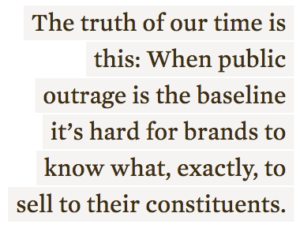 “One of the things that we found in doing our research about polarization is that two-thirds of Americans don’t think brands should talk directly about politics,” says Grinspan.
“One of the things that we found in doing our research about polarization is that two-thirds of Americans don’t think brands should talk directly about politics,” says Grinspan.
He brings up Whole Foods as an example of a brand that’s using its marketing to promote more universal values than those that come across as purely political. Values like, Whole Foods is for everyone. Or you don’t have to be a basket-weaving lefty to shop here. Everyone likes good food, right?
“Whole Foods is a good example of a company that understands who they’re talking to. Just because conservatives have a different view on energy policy doesn’t mean they are afraid of organic produce. I think Whole Foods does a terrific job of doing that without beating you over the head with their liberal values.”
In other words, brands do best when their marketing is as universally appealing as possible (good food!) and promotes values that anyone can get on board with (good food for all!).
But isn’t that exactly what Pepsi tried to do? Yes.
Did it fail totally? No. There’s another wrinkle in the Pepsi case study. People actually liked it, according to another Morning Consult analysis conducted in April of 2017, which surveyed 2,200 people for their reactions to the ad. It showed that, overall, 44 percent of viewers perceived Pepsi in a more favorable light after seeing the ad, compared to 25 percent of viewers who perceived the company less favorably.
And there’s more. Republicans had a lower opinion of the ad, according to a separate real-time survey conducted by Morning Consult among 2,000 people who identified as either Democrat or Republican. But the social media outrage directed at Pepsi was based in a critique of its approach, not of its politics. Which brings us back to the widening political divide—and the struggle brands face to straddle it and still sell product.
So, what’s the takeaway? There might not be a clear one. But perhaps the truth of our time is this: When public outrage is the baseline, it’s hard for brands to know what, exactly, to sell to their constituents.
“I think we’ve seen a titanic shift,” says Grinspan. “I think we used to be sex to sell or humor to sell, and I think 2017 was about people learning how to sell values. And values are different from politics. They’re deeply related to each other but they’re not inherently the same thing.”
(Maybe Pepsi is still finding its place on the values learning curve.)
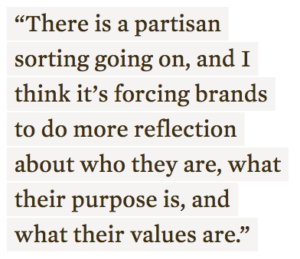 Grinspan cites immigration as an example of an issue that a brand might want to connect with its audience around. In that case, he says, a message of general inclusion would be better than, for instance, explicitly campaigning for the government to retain its Deferred Action for Childhood Arrivals (DACA) policy.
Grinspan cites immigration as an example of an issue that a brand might want to connect with its audience around. In that case, he says, a message of general inclusion would be better than, for instance, explicitly campaigning for the government to retain its Deferred Action for Childhood Arrivals (DACA) policy.
But that brings us back to the possibility of appearing toothless. If taking a specific stance, as Starbucks and Chick-Fil-A have, and promoting “universal” values, as Pepsi attempted to, beget outrage, then it appears there’s no way to win.
However, if you consider the bottom line, there might not be any tangible way to lose, either.
It’s tough to put an actual number on the impact that polarizing can have on a company’s financials, and given how volatile investor sentiment can be, it’s not a good idea to assign momentary surges or drops in trading value to specific PR fumbles. But it’s clear that food and beverage brands can, in fact, recover from an outbreak of outrage.
And with that comes an interesting corollary: Indignation, no matter how loud, isn’t always equal to action.
Chick-Fil-A’s charitable arm continues to fund anti-LGBTQ organizations. And yet, since the 2012 boycott, the company has established popular outposts in liberal-leaning enclaves like New York City, Seattle, and Portland, with more expansions on the docket, including a location in Buffalo, New York.
As for Pepsi, the company’s stock price actually rose on the day of its “Resistance” ad release, closing at $112.08 per share, compared to $111.86 the day prior. In fact, the soda conglomerate may have somehow shot itself in the corporate foot: Its trading value dipped to $111.94 per share the day it apologized.
To develop a constituency in 2018, Grinspan says brands will have to do some navel-gazing: “There is a partisan sorting going on, and I think it’s forcing brands to do more reflection about who they are, what their purpose is, and what their values are.”
Or maybe they just need to be more calculating. Take a stand, but make sure it’s a popular one. Last week, Burger King released an ad titled “Whopper Neutrality,” wading into the net neutrality debate. The ad won plaudits from Eater and other publications for its compelling, spot-on distillation of the issue. But here’s the thing: Americans overwhelmingly support net neutrality. (83 percent of voters are in favor, according to a University of Maryland poll). So as principled stands go, Burger King’s was a pretty easy one to take.
Pepsi, meanwhile, is trading at an all-time high.
